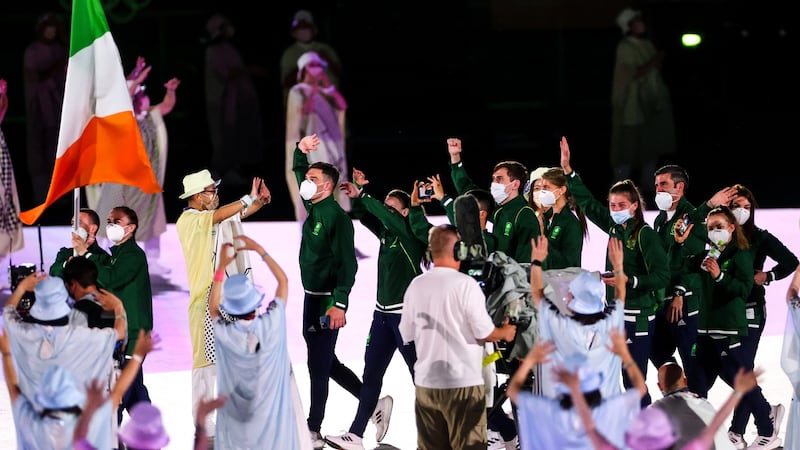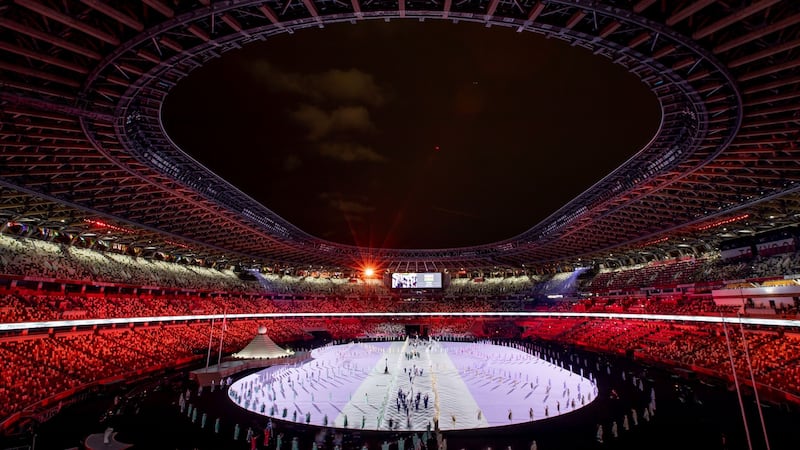Boxers Brendan Irvine and Kellie Harrington proudly carried the Irish flag as the Olympic opening ceremony kicked off on Friday in Tokyo, officially marking the start to the summer games one year after originally planned.
Boxing is Ireland’s most successful Olympic sport, with 16 of the 31 Irish medals having been won by boxers. Irvine is competing in his second Olympic Games, while Harrington is embarking on her first, and is going into the tournament as one of the top seeded boxers in the lightweight (-60kg) category.
In an opening ceremony marked by simplicity, one tradition held as athletes paraded into the Olympic stadium by national groups, waving but with smiles hidden behind masks, and most having both male and female flagbearers for the first time.

The Tokyo Games like no other opened with fireworks illuminating an almost empty National Stadium and a moment of silence to honour those lost to Covid-19, with a nod to Japanese tradition represented by wooden Olympic rings linked to the 1964 Games.
Postponed for a year, organisers were forced to take the unprecedented step of holding the Olympics without fans as the novel coronavirus is on the rise again, taking lives around the world.
Even the opening ceremony, normally a star-studded display teeming with celebrities was eerily silent, with fewer than 1,000 people in attendance, strict social distancing rules and signs calling on the spectators to “be quiet around the venue.”
Regardless, it marks a coming together of the world, with an audience of hundreds of millions around the globe and at various stages of the pandemic tuning in to watch the start of the greatest show in sport.
Some athletes were expected to use it to make statements about equality and justice and most nations were represented by a man and a woman after the organisers changed their rules to allow two flagbearers.
A vastly smaller number of athletes, about 20 per nation, marched in the teams’ parade, with many flying in just before their competitions and due to leave shortly after to avoid infections.
Most groups just walked quietly and waved, but the Argentina delegation bounced up and down.
The opening video featured at the stadium recapped Japan’s path to the Games and the challenges the world has faced since the selection of the Japanese capital as host in 2013.

It showed how in 2020 the coronavirus struck, with lockdowns forcing the unprecedented postponement only four months before the Games were supposed to open, setting off a roller-coaster period of uncertainty and preparations in isolation for the athletes.
A moment of silence was held “for all those family and friends we have lost,” especially to the coronavirus, and mention was made of the Israeli athletes slain at the 1972 Munich Games.
Japan had billed the Olympics as an echo of the 1964 Tokyo Games, which marked the country’s return to the world stage after its devastating World War Two defeat, but this time showcasing its recovery from the 2011 earthquake, tsunami and nuclear crisis.
In the segment highlighting the impact of the pandemic on the athletes and people around the world unable to see the Olympics in person, the organisers showed a lone female athlete, Japanese boxer nurse Arisa Tsubata training in the darkness, running silently on a treadmill.
Japanese emperor Naruhito and International Olympic Committee (IOC) president Thomas Bach, both masked, entered the stadium and bowed to each other before sitting down socially distanced.
The giant wooden rings were carried onto the field on a platform, guided by the light of many paper lanterns. With the pull of a rope, the rings were transformed into the Olympic symbol.
The rings make use of lumber from thinned trees that grew from the seeds borne by athletes from each of the participating nations to the previous Olympics hosted by Tokyo.
The opening is taking place without the usual mass choreography, huge props and cornucopia of dancers, actors and lights associated with past celebrations.
Only 15 global leaders are in attendance, along with emperor Naruhito, who will formally open the Games as his grandfather Hirohito did in 1964, and US first lady Jill Biden.
The ceremony is marked by high-profile absences, including former prime minister Shinzo Abe, who wooed the Games to Tokyo. A number of top sponsors and economic leaders will also stay away, highlighting strong opposition to the sporting extravaganza in Covid-fatigued Japan.
Hundreds of protesters carrying placards that read “Lives over Olympics” protested around the venue. The protesters, a mix of people in white surgical masks, yelled “Stop the Olympics” as they marched.
Only a third of the nation have had even one dose of vaccines, prompting worries the Games could become a super-spreader event. More than 100 people involved with the Olympics have already tested positive.
The Olympics have been hit by a string of scandals, including the exit of senior officials over derogatory comments about women, jokes about the Holocaust and bullying.
The Games run until August 8th. About 11,000 athletes from 204 national Olympic committees are expected, along with a team of refugee athletes competing under the Olympic flag.













